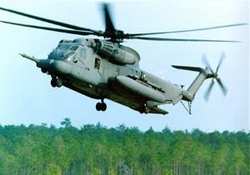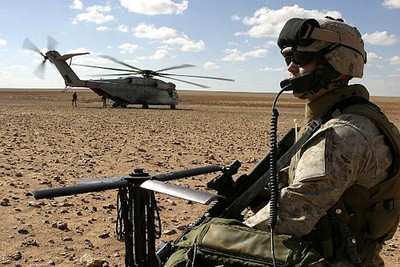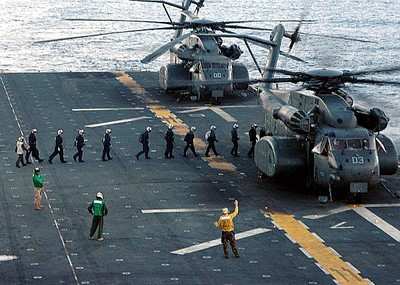Venerable Helo Will Conduct Assault Support
 Neither chart-busting techno
thrillers nor action-packed Hollywood block busters are likely to
use their daily routine for plot fodder any time soon, but that's
never fazed the MH-53E Sea Dragon crews of Helicopter Support
Squadron Four.
Neither chart-busting techno
thrillers nor action-packed Hollywood block busters are likely to
use their daily routine for plot fodder any time soon, but that's
never fazed the MH-53E Sea Dragon crews of Helicopter Support
Squadron Four.
Delivering critically needed spare parts, mail, passengers and
other high-priority cargo to carrier battle groups and
expeditionary strike groups transiting the Mediterranean and
Persian Gulf, the heavy lift/vertical onboard delivery specialists
assigned to the Sigonella, Sicily Naval Air Station have gotten
used to seeing others head to the fight.
That's about to change.
With the help of the Naval Air Systems Command's H-53 Heavy Lift
Helicopter Program, Rotary Wing Test Squadron 21, NAVAIR Cherry
Point's Fleet Support Team and Helicopter Mine Countermeasures
Squadron 14, the Black Stallions of HC-4 will soon head to the
fight themselves armed with a new mission -- assault support.
Not bad for a squadron formerly headed for the archives.
"In the past year, our squadron was going to be disestablished,"
explains HC-4's Lt. Todd Tavolazzi. "This opportunity came up to go
to support the war and we're all pretty excited."
Although designed to pull mine countermeasures equipment through
the water, the Sea Dragons assigned to HC-4 are primarily used to
ferry cargo to ships at sea from their base in Sigonella, according
to Tavolazzi. Going to austere forward operating locations ashore
in Iraq in direct support of ground forces represents a new
challenge for the Navy crews.
"For the end user like us it's a huge effort to learn all these
new tactics and environments we're not as familiar with," Tavolazzi
explains. "The Marines have this all ingrained, but it's new to
us."
To help them prepare, NAVAIR's H-53 program office is making
sure upgrades designed for the aircraft at Cherry Point, North
Carolina enable the Black Stallions to "git 'er done" in Iraq.
"We typically associate the assault support mission with the
Marine Corps' CH-53E and the MH-53E with vertical onboard delivery
and airborne mine countermeasures," says Marine Capt. Tom Page, the
H-53 program's avionics systems project officer. "To enable the
MH's to pick up the assault support mission, we're installing the
GAU-21 ramp-mounted .50-caliber machine gun, ALE-47/AAR-47 missile
warning and countermeasures suite, the ballistic protection system,
and we're making sure the cockpit is compatible with night vision
devices."

The $5 million effort will modify eight aircraft assigned to
both HC-4 and the Norfolk, Virginia-based HM-14. Ultimately,
program officials hope to upgrade all 34 aircraft in the Navy's
MH-53E fleet.
Aggressive and ambitious, according to Navy Lt. Cmdr Dave
Padula, the H-53 program's assistant program manager for systems
engineering, the initial tasking was received in February and the
schedule calls for testing to be complete by the end of June. The
squadron is to be completely trained and equipped by the end of the
year.
"All these systems have been tested already on the CH-53E," says
Maj. Hank Vanderborght, HX-21's H-53 test pilot here. "All we're
doing here is verifying that we have no issues with putting them on
the MH-53E.
"The biggest issue is determining if the different airflow
[caused by the MH-53E's larger sponsons) affects link and casing
separation [from the GAU-21] and flare dispensing," he adds. "We'll
also be testing the aircraft's electromagnetic environment
compatibility with other aircraft and aboard ship and upgrading the
cockpit lighting to make it compatible with night vision
devices."
Despite a seemingly straightforward and easy test program,
Vanderborght isn't complacent.
"Nothing in testing is simple," he quips.
In addition to the aircraft modifications, training the aircrews
is an equally important part of the mission preparation. A few of
HC-4's pilots are attending the Marine Corps weapons and tactics
course given by Marine Aviation Weapons and Tactics Squadron One at
Yuma, Ariz, according to Padula. They, in turn, will return to the
squadron and instruct the other crews in assault support
tactics.
Others will be learning NVG tactics with the Marines' reserve
CH-53E squadron at Willow Grove, PA.

"We have a lot of work ahead of us," admits Tavolazzi.
But well worth the effort, according to Sgt. Tom Dungan, H-53
crew chief at HX-21 -- himself an Iraq combat veteran with 96
missions.
"You can't have enough '53's in country so it will be great
having the Navy helping out," he says.
 Aero-News: Quote of the Day (05.15.25)
Aero-News: Quote of the Day (05.15.25) NTSB Final Report: Avia Stroitel AC-5M
NTSB Final Report: Avia Stroitel AC-5M ANN's Daily Aero-Linx (05.15.25)
ANN's Daily Aero-Linx (05.15.25) Airborne 05.09.25: Frecce Tricolori MidAir, A6M3 Zero Returns, Houthis Bombed
Airborne 05.09.25: Frecce Tricolori MidAir, A6M3 Zero Returns, Houthis Bombed ANN's Daily Aero-Linx (05.16.25)
ANN's Daily Aero-Linx (05.16.25)





